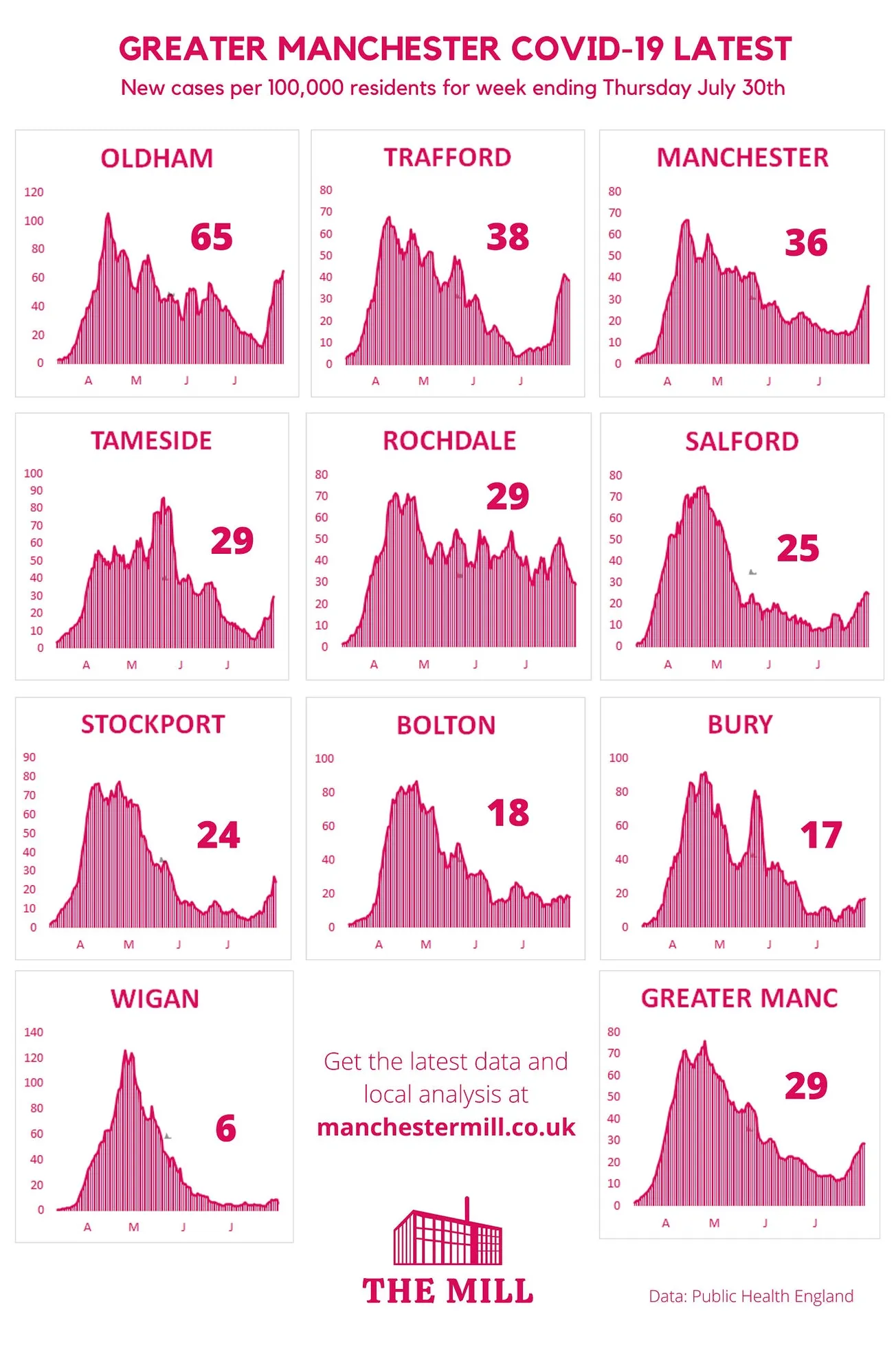Good afternoon Millers. The government has just published the legislation which makes the new lockdown restrictions we are living under legally enforceable. I’ll briefly summarise what it says below.
This briefing also looks at how fast the virus is spreading in the different boroughs of Greater Manchester, based on the latest data from Public Health England. To help you understand what is going on, I spoke to John Burn-Murdoch, the brilliant data journalist who has been crunching coronavirus numbers for The Financial Times. And I’ve made my first attempt to answer the question some of you have been asking in the comments: How much do these rising infection rates have to do with increased levels of testing?
If you think someone you know might find this post useful, please use the share button below and encourage them to join The Mill’s email list.
What the law says
From tomorrow it will be illegal for residents of Greater Manchester to meet someone in a private dwelling, no matter where that dwelling is, unless they are from the same household or are part of a support bubble together. That’s the most important bit of the legislation published this afternoon, which you can read here.
Here’s a brief run-down of other important bits as I understand them.
- The law covers the whole of Greater Manchester (and bits of Lancashire and West Yorkshire too), but it allows the health secretary to swap areas out if he wants to.
- It will be reviewed every two weeks, with the first review on August 19th.
- The no-home-visits rule has a bunch of exceptions, including if someone is giving birth, if you believe someone is dying or if you are fulfilling a legal obligation by making the visit.
- There is also an exception for where a gathering is “reasonably necessary” which includes moving house, if the gathering is for work purposes or to do with charitable services, for the purpose of education, for childcare done by professionals, to provide care to a vulnerable person, or to enable access to a child for a parent who has existing arrangements to see them.
- Private dwellings include gardens and sheds and garages but do not include hotels, hostels, campsites or care homes.
- Gatherings in public places are restricted to 30 people unless that place is operated by a business, a charitable institution or a public body as a visitor attraction, and the gathering is organised by one of those types of bodies.
- If you break the rules, you can be fined £100. The next offence is fined at £200, and fines for subsequent ones rise at intervals of £200. For the hardcore illegal socialisers there is a top fine of £3,200 for the sixth and all subsequent offences.
As far as I can see, there is no mention of meeting people from other households in pubs or cafes, despite that being included in the government announcement last week as a thing you “should not” do. We will have to see how ministers explain that one, or if the wording of the announcement is changed in the coming days.
Join The Mill’s email list below to get balanced, ad-free Manchester journalism in your inbox every week
The latest infection rates
In the graphic below you can see the latest infection rates for every Greater Manchester borough, and graphs showing how those rates have changed since the virus began showing up.
A quick note on the data: The infection rate is basically positive tests over the most recent seven days for which data is available, per 100,000 inhabitants. The rates shown below are for the week ending last Thursday, the day the new local restrictions were imposed. Data from the past four days is still too provisional to use.
If you want to share the graphic, you can find it on Twitter here, and on Facebook here.

What are these numbers telling us? A few obvious things jump out:
- There has been a clear uptick in new cases across Greater Manchester compared to early-to-mid July, which for most areas saw the lowest infection rates since the start of the pandemic. But whereas places like Oldham and Trafford have tripled or quadrupled their rate in two weeks, Bolton and Wigan’s has only gone up by about a third, and Rochdale’s has fallen.
- These infection rates are still well below the peak rates each borough experienced in the spring. The graphs show that really clearly. They are also nowhere near the kinds of spread we saw in Leicester in late June, which recorded a rate over 150 in one week. Of course, some of these boroughs could still reach Leicester Level if their numbers keep growing this week and I’ll update the graphic to track that.
- The overall picture does not look dramatically worse than it did when the new restrictions were announced. Tameside and Stockport have grown the fastest compared to the rates we could see that day (which ended on Monday July 27th), but no borough has doubled its rate since then.
So why are we banned from having friends over if most of these numbers are well below peak rates? “The way I'm reading that is: it means the government is just trying to be super super safe,” says Burn-Murdoch, whose data analysis of the virus for the FT has won him a huge global following on Twitter. He told The Mill:
No one wants a proper second wave - no one wants to be Australia right now. So you absolutely stamp out anything as soon as the numbers start going up. On paper, based on what we know about the numbers versus where they were in March/April, the restrictions [in Greater Manchester and other parts of the North] are unnecessarily strict. But I think that's by design and it’s completely defensible.
Another reason for the swift action in Greater Manchester is that our outbreaks bear the hallmarks of “community spread” - meaning that they are not focused on a single factory or distribution centre, like this week’s spike in Swindon. That makes them harder to fight and means the authorities have reached for broad restrictions.
If you like this kind of journalism you can join The Mill’s mailing list below
A testing question
Several of you asked whether the increased case numbers might just be the result of more testing. Whenever I quote infection rates, I always make the point that they are highly contingent on how many tests a local authority is doing.
Well I asked the three councils with the highest rates - Oldham, Trafford and Manchester - whether they have increased testing in the past month. Manchester haven’t sent me the numbers yet. Oldham are going to publish testing data on their website in the next 24 hours, they say. But Trafford sent The Mill their numbers and they are very interesting. They show that Trafford massively ramped up testing through July, much faster than the national ramping up of testing.
In the first week of the month, the borough’s Mobile Testing Units did 268 tests, and 377 in the second. In the third they did 548, and during the final week of the month they did 745. That’s an increase of 177 per cent from week one to week four, or almost three times as many tests. We can compare that to how the borough’s infection rate has risen in the same period. For the first week of July, Trafford’s infection rate was just under 6. In the week ending the 30th (shown in the graphic above) it was 38, more than six times higher, or 550 per cent higher. Meaning that more than six times more positive tests were recorded in the final week, per 100,000 residents.
Now these are back-of-the-envelope calculations because I don’t know how many Traffordians (particularly in the south of the borough) went to get tested at Manchester Airport, and there are probably other quirks with the data like how focused the testing is now versus a month ago. But we can say with some confidence that yes, Trafford is doing a lot more testing and that increased testing will be finding more cases than the previous testing regime was finding. But also that the “positivity rate” in Trafford seems to have risen - i.e. a higher percentage of people who are taking tests in the borough are coming back with positive results. Very roughly, it looks like more testing might account for something like a third of the increase in positives in Trafford.
“It suggests things aren't on a runaway train but equally it suggests we weren't picking up the full portion of people who had it,” says Burn-Murdoch about Trafford on hearing the figures. I’ll report back once I’ve got this data from more councils.
If you think someone you know might find this briefing useful, please share it using the button below.
And if you were sent this or found it online, please join The Mill’s email list below to get factual journalism and thoughtful writing about Manchester and the region direct to your inbox every week.

Comments
How to comment:
If you are already a member,
click here to sign in
and leave a comment.
If you aren't a member,
sign up here
to be able to leave a comment.
To add your photo, click here to create a profile on Gravatar.






